Lights Over Lapland is excited to announce that our Customisable Aurora Adventures are available for immediate booking! Reserve your adventure of a lifetime in Abisko National Park, Sweden today! | | |
GEOMAGNETIC STORM UNDERWAY: A G1-class geomagnetic storm is underway on Aug. 31st as Earth enters a stream of fast moving solar wind. First contact with the stream sparked bright auroras over Alaska. Forecasters expect the solar wind around Earth to blow faster than 600 km/s for at least the next 24 hours, so more high-latitude auroras are possible on Sept.1st. Free: Aurora Alerts
A NEW KIND OF SPRITE? Barely 30 years ago, many researchers did not believe that upper atmospheric lightning existed—until 1989 when researchers from the University of Minnesota captured them on video tape. Now there is a menagerie of accepted forms: sprites, elves, gigantic jets, gnomes. These "transient luminous events" (TLEs) appear above thunderclouds, reaching toward space rather than lancing down to the ground like regular lightning.
On Aug.14th, Thomas Ashcraft may have spotted a new kind of sprite. "I was photographing a cluster of sprites over a thunderstorm in western Oklahoma when something curved snaked up behind the main cluster." This frame from his video of the event shows the strange form:
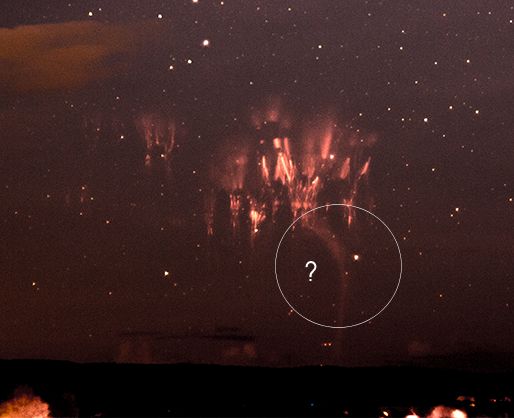
What was it? Experts aren't sure.
Lightning researcher Oscar van der Velde at the Technical University of Catalonia says it could be a troll—a type of TLE that sometimes appears underneath sprites, crawling up tendrils dangling beneath the luminous clusters. "I have recorded many trolls," says van der Velde, "but never such weird curving ones. This is a really exceptional display."
Jozsef Bo'r of the Geodetic and Geophysical Research Institute in Hungary thinks it might be a type of gigantic jet. Gigantic jets are like sprites on steroids—powerful and bright. "A working hypothesis is that the red sprites in the photo occurred first and deposited a cloud of positive charge above the thundercloud. A subsequent gigantic jet was itself rich in positive charge and had to bend around the positive cloud on its way up."
Or it could be something unprecedented. "Even after almost 30 years of sprite observations, we are still seeing new things," says Walter Lyons, past president of the American Meteorological Society and a longtime observer of sprites. "Over the years I have seen thousands of sprites, but only a few curved structures like this -- so this is pretty rare."
"I don't know what to call them," says Ashcraft, who regularly monitors the sky around his private observatory in New Mexico for strange phenomena, "but I am going to keep my eyes open for more."
Realtime Sprite Photo Gallery
EDGE OF SPACE ECLIPSE PENDANTS: On Aug. 21st during the Great American Solar Eclipse, the students of Earth to Sky Calculus launched 11 space weather balloons from the path of totality. They aimed to photograph the Moon's shadow from the stratosphere--and they succeeded. As a fundraiser, some of the balloons carried pendants into the eclipse. Here's one dipping in and out of the Moon's shadow more than 86,000 feet above the Malheur National Forest in eastern Oregon:
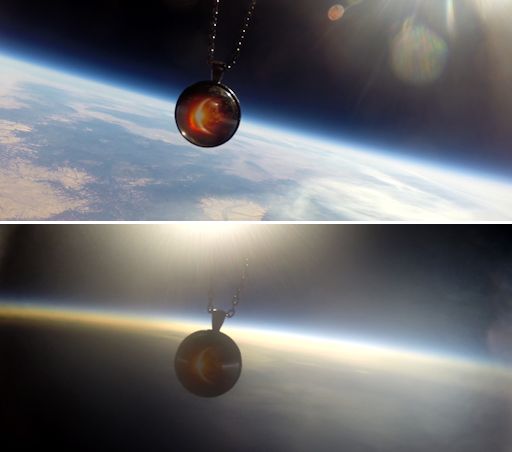
During the 2.5 hour flight, the pendants were wrapped in the Moon's shadow for more than two minutes, experiencing a spooky darkness colder than -50 C.
You can have one for $149.95. Each pendant comes with a unique gift card showing the jewelry passing through the Moon's shadow and floating at the top of Earth's atmosphere. The interior of the card tells the story of the flight and confirms that this gift has been to the edge of space and back again.
Far Out Gifts: Earth to Sky Store
All proceeds support hands-on STEM education
ASTEROID FLORENCE APPROACHES EARTH: Asteroid 3122 Florence is approaching Earth for a 7 million km close encounter on Sept. 1st. There's no danger of a collision, but the space rock is large (4.4 km across) and it will be visible in small amateur telescopes during the nights around closest approach. Michael Jäger photographed the approaching asteroid from his private observatory in Weißenkirchen, Austria, on Aug. 29th:
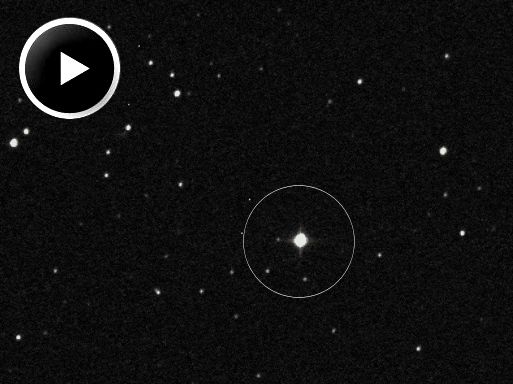
"What a fast mover," says Jäger. "Minor planet Florence is now near Earth and shining like a star of magnitude +8 to +9."
Named in honor of Florence Nightingale (1820-1910), "this is the largest asteroid to pass by our planet this close since the NASA program to detect and track near-Earth asteroids began," says Paul Chodas, manager of NASA's Center for Near-Earth Object Studies at JPL. Radar imaging is planned at NASA's Goldstone Solar System Radar in California and at the National Science Foundation's Arecibo Observatory in Puerto Rico. The resulting radar images could reveal surface details as small as 10 meters. Stay tuned.
Realtime Space Weather Photo Gallery
Solar Eclipse Photo Gallery
Realtime Aurora Photo Gallery
Every night, a network of
NASA all-sky cameras scans the skies above the United States for meteoritic fireballs. Automated software maintained by NASA's Meteoroid Environment Office calculates their orbits, velocity, penetration depth in Earth's atmosphere and many other characteristics. Daily results are presented here on Spaceweather.com.
On Aug. 31, 2017, the network reported 15 fireballs.
(15 sporadics)
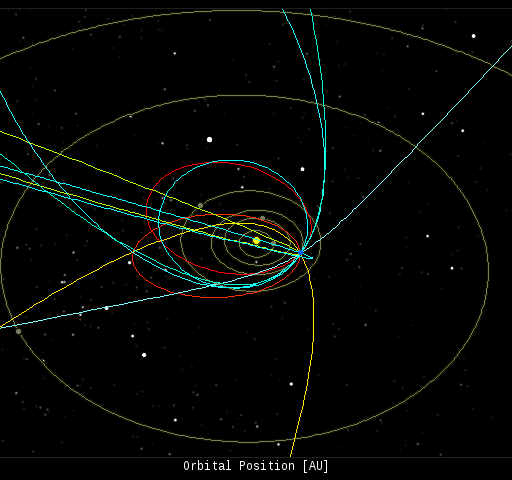
In this diagram of the inner solar system, all of the fireball orbits intersect at a single point--Earth. The orbits are color-coded by velocity, from slow (red) to fast (blue). [Larger image] [movies]
Potentially Hazardous Asteroids (
PHAs) are space rocks larger than approximately 100m that can come closer to Earth than 0.05 AU. None of the known PHAs is on a collision course with our planet, although astronomers are finding
new ones all the time.
On August 31, 2017 there were 1803 potentially hazardous asteroids.
 |
Recent & Upcoming Earth-asteroid encounters: | Asteroid | Date(UT) | Miss Distance | Velocity (km/s) | Diameter (m) |
| 2017 QQ17 | 2017-Aug-26 | 1 LD | 21.2 | 8 |
| 2017 QX1 | 2017-Aug-26 | 12.9 LD | 7 | 39 |
| 2017 QU1 | 2017-Aug-27 | 16.2 LD | 10.1 | 37 |
| 2017 PL26 | 2017-Aug-28 | 14.2 LD | 8.4 | 130 |
| 2017 QN1 | 2017-Aug-30 | 5.5 LD | 10.5 | 17 |
| 2017 QP2 | 2017-Aug-30 | 10.1 LD | 7.5 | 33 |
| 2017 QQ1 | 2017-Aug-31 | 4.8 LD | 10.2 | 39 |
| 3122 | 2017-Sep-01 | 18.5 LD | 13.5 | 5376 |
| 2017 QT17 | 2017-Sep-01 | 17.3 LD | 10 | 55 |
| 2017 QG18 | 2017-Sep-01 | 4.4 LD | 6.6 | 13 |
| 2017 QV32 | 2017-Sep-02 | 12 LD | 11 | 21 |
| 2017 QR32 | 2017-Sep-02 | 2.8 LD | 18 | 17 |
| 2017 OP68 | 2017-Sep-10 | 20 LD | 11.7 | 296 |
| 2017 QK18 | 2017-Sep-11 | 14.8 LD | 7.8 | 46 |
| 2014 RC | 2017-Sep-11 | 15.1 LD | 8.9 | 16 |
| 2017 PR25 | 2017-Sep-23 | 17.9 LD | 13.5 | 234 |
| 1989 VB | 2017-Sep-29 | 7.9 LD | 6.3 | 408 |
| 2012 TC4 | 2017-Oct-12 | 0.1 LD | 7.6 | 16 |
| 2005 TE49 | 2017-Oct-13 | 8.5 LD | 11.2 | 16 |
| 2013 UM9 | 2017-Oct-15 | 17 LD | 7.8 | 39 |
| 2006 TU7 | 2017-Oct-18 | 18.7 LD | 13.3 | 148 |
| 171576 | 2017-Oct-22 | 5.8 LD | 21.2 | 677 |
Notes: LD means "Lunar Distance." 1 LD = 384,401 km, the distance between Earth and the Moon. 1 LD also equals 0.00256 AU. MAG is the visual magnitude of the asteroid on the date of closest approach. | | Cosmic Rays in the Atmosphere |
Readers, thank you for your patience while we continue to develop this new section of Spaceweather.com. We've been working to streamline our data reduction, allowing us to post results from balloon flights much more rapidly, and we have developed a new data product, shown here:
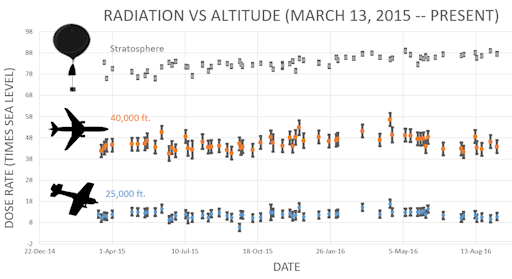
This plot displays radiation measurements not only in the stratosphere, but also at aviation altitudes. Dose rates are expessed as multiples of sea level. For instance, we see that boarding a plane that flies at 25,000 feet exposes passengers to dose rates ~10x higher than sea level. At 40,000 feet, the multiplier is closer to 50x. These measurements are made by our usual cosmic ray payload as it passes through aviation altitudes en route to the stratosphere over California.
What is this all about? Approximately once a week, Spaceweather.com and the students of Earth to Sky Calculus fly space weather balloons to the stratosphere over California. These balloons are equipped with radiation sensors that detect cosmic rays, a surprisingly "down to Earth" form of space weather. Cosmic rays can seed clouds, trigger lightning, and penetrate commercial airplanes. Furthermore, there are studies ( #1, #2, #3, #4) linking cosmic rays with cardiac arrhythmias and sudden cardiac death in the general population. Our latest measurements show that cosmic rays are intensifying, with an increase of more than 13% since 2015:
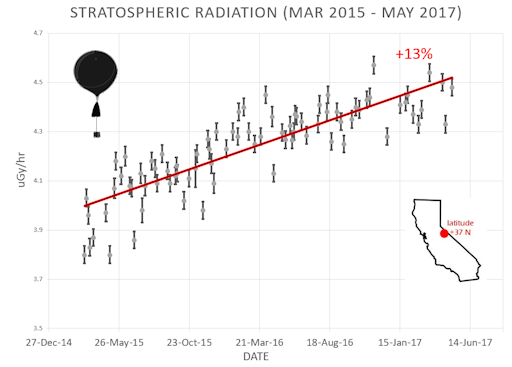
Why are cosmic rays intensifying? The main reason is the sun. Solar storm clouds such as coronal mass ejections (CMEs) sweep aside cosmic rays when they pass by Earth. During Solar Maximum, CMEs are abundant and cosmic rays are held at bay. Now, however, the solar cycle is swinging toward Solar Minimum, allowing cosmic rays to return. Another reason could be the weakening of Earth's magnetic field, which helps protect us from deep-space radiation.
The radiation sensors onboard our helium balloons detect X-rays and gamma-rays in the energy range 10 keV to 20 MeV. These energies span the range of medical X-ray machines and airport security scanners.
The data points in the graph above correspond to the peak of the Reneger-Pfotzer maximum, which lies about 67,000 feet above central California. When cosmic rays crash into Earth's atmosphere, they produce a spray of secondary particles that is most intense at the entrance to the stratosphere. Physicists Eric Reneger and Georg Pfotzer discovered the maximum using balloons in the 1930s and it is what we are measuring today.
| | The official U.S. government space weather bureau |
| | The first place to look for information about sundogs, pillars, rainbows and related phenomena. |
| | Researchers call it a "Hubble for the sun." SDO is the most advanced solar observatory ever. |
| | 3D views of the sun from NASA's Solar and Terrestrial Relations Observatory |
| | Realtime and archival images of the Sun from SOHO. |
| | from the NOAA Space Environment Center |
| | a proud supporter of science education and Spaceweather.com |
| | fun to read, but should be taken with a grain of salt! Forecasts looking ahead more than a few days are often wrong. |
| | from the NOAA Space Environment Center |
| | the underlying science of space weather |
 | Beautyz for top beauty products reviews and their buying guides |
 | Reviews here can help you to pick up best memory foam mattresses. |
| | These links help Spaceweather.com stay online. Thank you to our supporters! |
| | | | | | |

